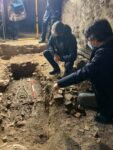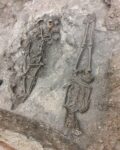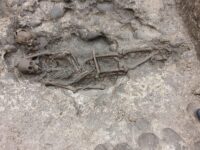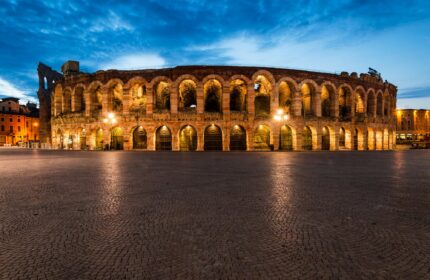Skeletal remains of four individuals have been discovered underneath the arches of Verona’s iconic Roman arena. These are the first burials ever found inside the amphitheater’s archways.
 The first was discovered in December during a comprehensive program of restoration and infrastructure improvements in the archways of the amphitheater. Archaeologists found traces of burning between the walls of Arch 31 and expected to unearth evidence the arch had been used a blacksmith’s forge as similar finds have been made in previous excavations. Instead, they unearthed an unprecedented burial. The remains were of an adult woman buried with her arms folded across her chest. Potsherds used to pave the floor in the 1st century A.D. had been moved to make room for the burial. The depth of the grave suggests it dates to late antiquity, between the 3rd and 6th centuries.
The first was discovered in December during a comprehensive program of restoration and infrastructure improvements in the archways of the amphitheater. Archaeologists found traces of burning between the walls of Arch 31 and expected to unearth evidence the arch had been used a blacksmith’s forge as similar finds have been made in previous excavations. Instead, they unearthed an unprecedented burial. The remains were of an adult woman buried with her arms folded across her chest. Potsherds used to pave the floor in the 1st century A.D. had been moved to make room for the burial. The depth of the grave suggests it dates to late antiquity, between the 3rd and 6th centuries.
 Earlier this month, archaeologists came across another surprise burial, this time of three individuals under Arch 10. The remains are of an adult man and two adolescents around 16 years of age. One of the youths is morphologically female, with shorter limbs and smaller bones. The sex of the other has yet to be determined. Coins found in a small purse attached to the man’s circular buckle have been identified as “Enrician” coins, coinage dedicated to the four Henrys who were crowned King of the Romans in the 11th century struck by the Verona mint in the 12th century. Radiocarbon analysis will confirm his dates and those of the two adolescents.
Earlier this month, archaeologists came across another surprise burial, this time of three individuals under Arch 10. The remains are of an adult man and two adolescents around 16 years of age. One of the youths is morphologically female, with shorter limbs and smaller bones. The sex of the other has yet to be determined. Coins found in a small purse attached to the man’s circular buckle have been identified as “Enrician” coins, coinage dedicated to the four Henrys who were crowned King of the Romans in the 11th century struck by the Verona mint in the 12th century. Radiocarbon analysis will confirm his dates and those of the two adolescents.
The bodies were found in a central pit. The young woman’s head was pointing south. The adult man’s was as well and the other youth was next to him head pointing north. If viable DNA can be extracted, it should be possible to determine if there was any familial relationship between the three that explains their burial in such close quarters.
 In the wake of these discoveries, the restoration program will now also include archaeological investigations of all the internal archways to see if more of the small, narrow spaces were dedicated to funerary use. The burials will be included in the new museum itinerary dedicated to the arena’s 2000-year history which will open inside the amphitheater after the program of restoration is complete.
In the wake of these discoveries, the restoration program will now also include archaeological investigations of all the internal archways to see if more of the small, narrow spaces were dedicated to funerary use. The burials will be included in the new museum itinerary dedicated to the arena’s 2000-year history which will open inside the amphitheater after the program of restoration is complete.

Those “Enrician” coins, dedicated to the “four Henrys who were crowned King of the Romans in the 11th century struck by the Verona mint in the 12th century” are indeed very interesting:
Holy Roman Emperors, I reckon, were also crowned King of the Romans, and there are altogether six Henrys (the HRR Henrys II–VII), of which only three were crowned in the 11th century, i.e. Henrys II-IV, while V and VI were crowned in the 12th century, but coronations dates as ‘King of Italy’ and the ones as ‘Roman Emperor’ are not necessarily the same.
After attempts by the Magyars, Berengar II made the city the seat of a Frontier March. From 951 to 975, Verona was under the control of the Duchy of Bavaria. In 960, Berengar II had invaded the Papal States under Pope John XII, on whose appeal King Otto, aiming at his coronation as Holy Roman Emperor, marched against Italy once more.
Berengar II’s troops deserted and Otto declared Berengar deposed and proceeded to Rome, where he was crowned emperor, and Berengar was imprisoned at Bamberg in Germany, where he died in August 966. The ‘Marca di Verona’ was then held by the Dukes of Bavaria from 951-989 (a bunch of other Henrys!!!), and there was even a Veronese Monetary Union.
Apparently in 1117, Verona was hit by an earthquake that also damaged the arena. Maybe, those bodies are victims of that quake, and those coins are at least not ruling out that possibility. Myself, I am unable to tell how many victims there were, but maybe the rubble was moved aside, the victims buried and the arena finally repaired.
:hattip:
——-
PS: As far as the ‘paved Lady’ in the arena is concerned, please note that I don’t have any data on quakes between the 3rd and 6th centuries. To get ‘paved as a witch’ is maybe not a likely scenario, and at least the Magyars were clearly too late.
The pavement outside the arena…the cobbled surface with the interlaced arcs…is there a name for it…for the illusory overlapping of the scales?
That is quite interesting that they would burry people in the arena itself. Especially since the woman was buried carefully with her arms folded across her chest. Do you think this burial in the Verona Arena had a religious significance?